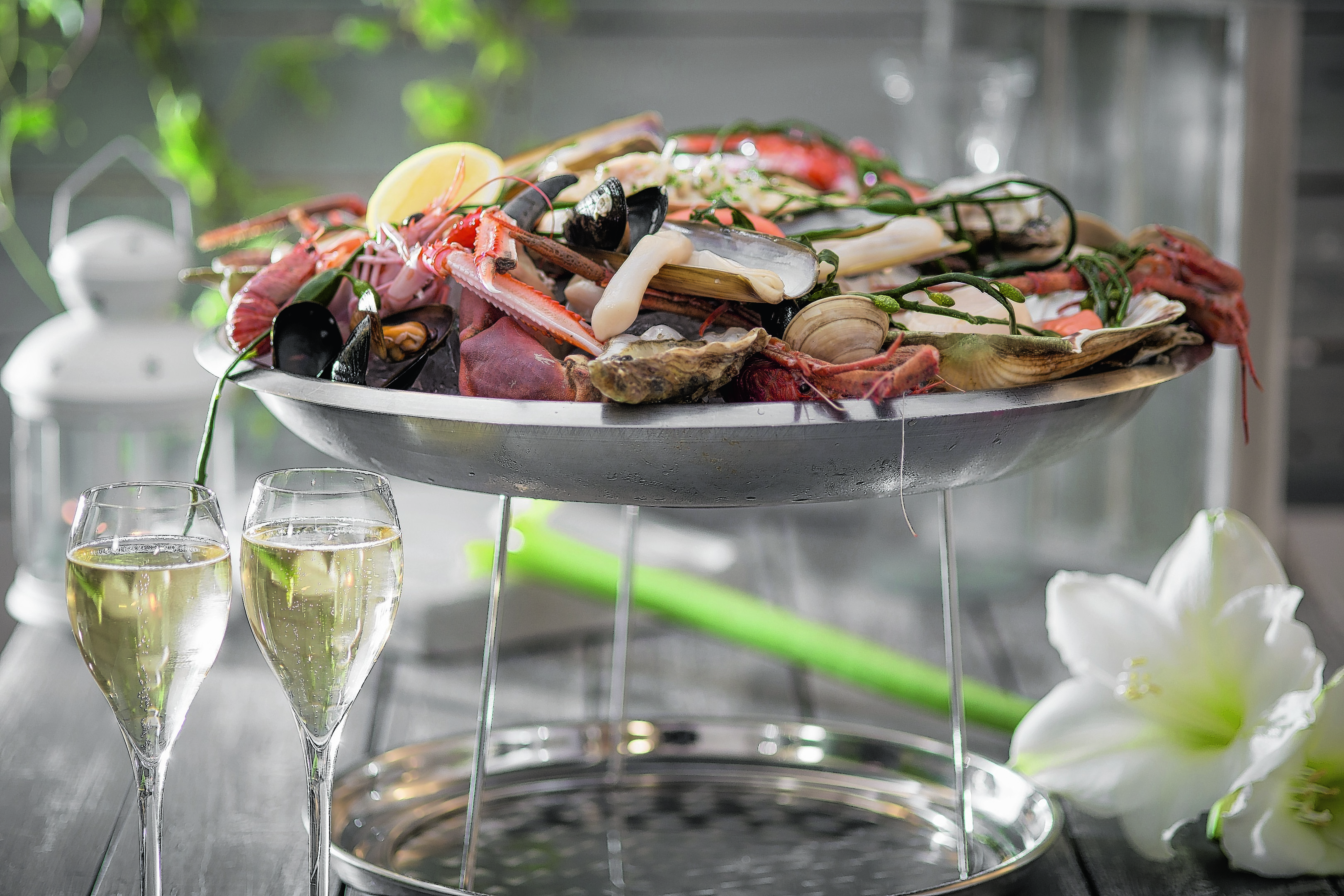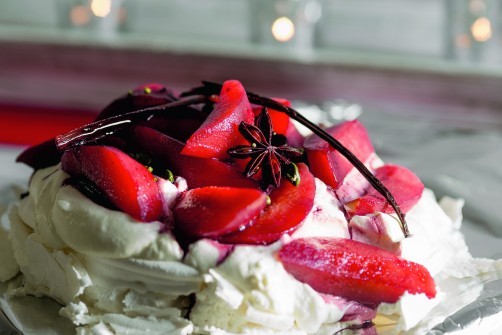Michelin-star chef Tom Kitchin creates romantic recipes to share with someone special
Like many men, I’m sure my wife would say I could be a bit more romantic at times.
Whenever we do get to enjoy a meal for ourselves, we always love sharing foods. I am a great fan of big platters with our favourite ingredients, laid in the middle of the table to enjoy and savour and thankfully Michaela really enjoys this way of eating too.
For those of you who share my love for this kind of food, I want to share some recipes that can be enjoyed either as a couple or among a group of friends if you’re planning a relaxed evening.
Both of these dishes are perfect for sharing whether it’s between two or for a much larger group. My recipes are a bit more challenging, but they’re a great chance to try something different and show off a little.
Fruit de Mer is a glorious dish and a wonderful feast whatever you’re celebrating. A French classic, it’s a combination of lots of delicious, fresh shellfish. For me, it is always incredibly tempting and a real treat for the eyes and the palate. It’s a dinner to take your time over, opening each shellfish slowly and enjoying the treasures you’ll find inside each shell.
When it comes to dessert, this Quince Pavlova is a real centre piece – getting the meringue just right takes patience but it will be worth it in the end. You can use any fruit that’s in season to suit your own taste but I always think the quince looks so wonderfully vibrant against the clean white of the meringue. A perfect finale to any celebratory dinner.
FRUIT DE MER
- SERVES 2
- You can use any fresh shellfish for this recipe – whatever your fishmonger has fresh that day
- 150g cockles (or winkles)
- 300g clams
- 300g mussels
- 6 razor clams
- 6 oysters
- 6 langoustine
- 6 scallops in their shells
- 1 whole crab
- FOR THE COURT BOUILLON:
- 2 litres water
- 1 fennel bulb
- 1 tsp fennel seeds
- 2 shallots chopped
- 8 peppercorns
- 1 bay leaf
- 1 sprig thyme
- 2 cloves garlic
- 1 carrot diced
- 6 cardamom pods crushed
- FOR THE MUSSELS AND RAZOR CLAMS:
- Splash olive oil
- 150 ml white wine
- 1 shallot chopped
- 1 tsp chopped parsley
- TO SERVE:
- Crushed ice
- 1 sliced lemon, cut into quarters
- Seaweed to garnish
Start by washing all the shellfish. Run the shells lightly under cold water and remove the beards, sand and impurities from the mussels, cockles, clams and razor clams. To prepare the cockles, langoustine and scallops you need to make a court bouillon – a stock that will allow the flavour to infuse into the shellfish.
Add the fennel bulb, fennel seeds, chopped shallots, peppercorns, bay leaf, thyme, garlic, carrot and cardamon pods into a pot and cover with 2 litres of water. Bring to the boil and cook for 10 minutes. Add the cockles and cook for 5-10 minutes. Add the langoustine to the court bouillon and cook for 3-4 minutes, then remove both the cockles and langoustine, and set aside. Remove the roe from the scallops if you wish, but for me leaving it on makes it look more dramatic. Poach the scallops in the court bouillon for 2-3 minutes, then also set aside.
To prepare the crab: Bring a pan of salted water to the boil making sure the water is well salted as this will bring out the flavour in the crab. Holding the crab from behind, carefully plunge each into the boiling water. When each crab hits the water the temperature will drop. Bring the water back to the boil and as soon as it boils, remove the pan from the heat, leaving the crab to cool in the water for 10-15 minutes. Remove the crab from the water.
To prepare the mussels and razor clams: You want to prepare the mussels and razor clams traditionally with a sauce of white wine, shallots and parsley. Heat a frying pan and add a splash of olive oil. Add the shallots, parsley and white wine and heat over medium heat. Slowly add the mussels individually, then place a lid over as soon as they begin to open. Remove the mussels and set aside. Add the razor clams to the shallots and white wine and cook just until the razor clams open and no more, before removing from the heat.
To prepare the oysters: To open the oysters simply press your knife into the hinge of the oyster slipping the knife along the shell avoiding spilling any of the beautiful juices.
To serve: For me this dish is always best if it’s cooked just before eating as you want it to be as fresh as possible. If the shellfish are still warm, it doesn’t matter. Place on a deep platter of crushed ice, and place all of the shellfish on top of the ice. Add sliced lemons and seaweed to garnish. Serve with fresh bread and homemade mayonnaise.
SEASONAL PAVLOVA WITH QUINCE
- SERVES 6-8
- For the meringue:
- 6 large egg whites
- 1 and a half tsp white wine vinegar
- 250g caster sugar
- 1 tsp cornflour
- MASCARPONE CREAM:
- 250ml whipping cream
- 50g icing sugar
- 150g mascarpone
- QUINCE TO FINISH:
- 2 x quince
- 1 litre red wine
- 200g sugar
- 2 star anise
- Cinnamon stick
- 1 vanilla pod
- 2 peelings orange skin
- 1 tbsp chopped pistachios
Heat the oven to 110 degrees. Line a large baking sheet with baking parchment. To make the meringue, using an electric mixer or electric hand whisk, whisk the egg whites with the wine vinegar until they begin to froth and increase in volume. Now whisk in two-thirds of the sugar, a little at a time. When stiff peaks form, add the remaining sugar and sift in the cornflour. Fold in, using a large metal spoon, until just incorporated.
Spoon the meringue into a mound in the centre of the baking sheet.
Using the back of the spoon, flatten the meringue into a large disc, beginning at the centre and working towards the edge. Make the edge of the meringue slightly higher to create a hollow for the filling to sit in. Bake for 1
Meanwhile, make the mascarpone cream. Whisk the cream and icing sugar together in a bowl to form soft peaks. Fold the mascarpone into the whipped cream, using a large metal spoon, keeping as much volume as possible. Cover and refrigerate. For the quince filling, add the sugar, cinnamon, orange peel and vanilla pod to the red wine and bring to the boil until the liquid forms a syrupy consistency.
Meanwhile peel the quince, cut in half then cut into wedges – the core can be removed carefully with a small knife. Place the quince in the syrup and poach for 12-15 minutes until soft. Leave the quince to cool in the syrup. Pour half the syrup off into another saucepan and bring to simmer, reducing the liquid until it thickens – the syrup should coat the back of a spoon.
Once your filling is ready fill the pavlova with the mascarpone cream, place the poached quince on top and drizzle with the syrup. Garnish with star anise and chopped pistachios.

